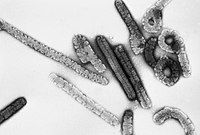
Photo from wikipedia
PurposeWe investigate the impact on outcome of different levels of supportive treatment in Ebola virus disease (EVD). The NGO EMERGENCY delivered care sequentially at two Ebola Treatment Centres (ETC) in… Click to show full abstract
PurposeWe investigate the impact on outcome of different levels of supportive treatment in Ebola virus disease (EVD). The NGO EMERGENCY delivered care sequentially at two Ebola Treatment Centres (ETC) in Sierra Leone: first at Lakka (fluids, symptomatic, antibiotic, antimalaria treatment, and hospital level medical care), and thereafter in Goderich, adding organ support in the only African ETC with an equipped and staffed intensive care unit (ETC-ICU).MethodsThe primary outcome in this retrospective cohort study was in-ETC mortality. Secondarily, we used multivariable logistic regression to investigate the independent impact of the IC on mortality by comparing patients in two ETCs, adjusting for potential confounders, including the viral load (base-10 logarithm in copies/ml) (LVL), modelled as a piecewise linear function. Mortality was plotted versus LVL. Confidence bands were constructed by a bootstrap technique. The number of hospital-free days within 28 was computed to assess the burden of EVD.ResultsData from 229 EVD patients were analysed (123 in Lakka, 106 in Goderich). Crude analysis showed a non-statistically significant difference in mortality (57.7% in Lakka vs 50.0% in Goderich; p = 0.19). Age and LVL were associated with mortality. Adjusted mortality was lower at the Goderich ICU-ETC (p = 0.055). This difference was observed with 80% confidence for patients with LVL between 7.5 and 8.5 copies/ml. Hospital-free days (of 28 days) were greater (7.7 vs 5.5; p = 0.03) for patients treated in the ICU-ETC.ConclusionsProvision of critical care to patients with EVD is feasible in resource-limited settings and was associated with improved survival and less time in hospital.
Journal Title: Intensive Care Medicine
Year Published: 2018
Link to full text (if available)
Share on Social Media: Sign Up to like & get
recommendations!